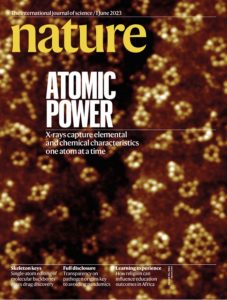Ohio University professors part of a breakthrough discovery with major implications for medicine
By: Gabriel Scotto
Posted on:
ATHENS, Ohio (WOUB) — A team of researchers, including two Ohio University professors, have become the first to successfully detect the signal of individual atoms, a discovery that could aid in the development of medicine for major diseases.
One potential application of this technology is the creation of new materials through atomic manipulation.
“Because materials are made from atoms, if you’re in control of atoms, you’re in control of materials,” said Saw-Wai Hla, a professor of physics at Ohio University and Argonne National Laboratory scientist, who led the research team. “If you can manipulate one atom’s properties to fit in with different types of atoms then you can create new materials from the ground up.”

Hla said this technology also has potential uses in medical science for curing diseases such as cancer and Alzheimer’s or in environmental science for detecting trace amounts of dangerous compounds like heavy metals.
“If we can tell what atoms are responsible for diseases like Alzheimer’s, we can find a cure,” Hla said. “I’m not a medical doctor, but this technology will offer medical scientists a way to use it. It can be a huge impact in coming years.”
The team’s paper reporting their discovery with major implications for medicine was the cover story in the June 1 issue of Nature, one the leading scientific journals.
“The idea (behind our experiment) was to see whether we could identify the nature and properties of atoms one atom at a time,” said Eric Masson, professor and department chair of chemistry at Ohio University.
This is accomplished through X-ray spectroscopy, in which atoms are excited with a beam of charged particles from an X-ray. The X-ray radiation interacts with the atoms, with energy released in the form of photons, or particles of light. An X-ray spectrometer measures the wavelengths of these photons, allowing for scientists to identify a material’s chemical composition and understand its properties.
“The discovery of X-rays was a transformative event for all of us in science,” Hla said. “Not only do X-rays give us the ability to take images, but they also give us the ability to tell what types of materials we’re dealing with.”
In the past, X-ray spectroscopy was unable to detect the signal of a single atom, as it was too weak to be detected. The research team used a technique known as synchrotron X-ray STM. The tip of a scanning tunneling microscope (STM), which allows for the imaging of surfaces at an atomic level, is used to scan a sample while it is exposed to an X-ray beam from a synchrotron.
By combining the atomic resolution of an STM with the chemical sensitivity of X-ray spectroscopy, the research team was able to scan the signals of individual terbium and iron atoms.
“If you want to detect one atom, you need to find a way to isolate that atom,” Hla said. “We decided it was a good idea to use a big molecule, but with only one metal atom, to prove we can detect a metal atom.”
To do this, Masson designed one of the molecules, a rare-earth complex, and synthesized them so Hla could manipulate them at the atomic level, using the tip of an STM.
“Atomic manipulation is really a collaboration between physicists and chemists,” Masson explained. “My role in this work is to design the molecules. We synthesize the molecules and (Hla) manipulates them.”
The first supramolecular system used for the study, an iron-containing supramolecule, was synthesized by a group led by Xiaopeng Li, a professor at the College of Chemistry and Environmental Engineering at Shenzhen University in China.
“With atomic manipulation, we can control the atoms and reposition them to where we want them to be,” Hla said. “We can create nanostructures with the atoms or investigate their properties such as the number of electrons and its magnetic properties.”
The type of molecules used in this experiment are coordination complexes. These are molecules in which organic ligands, made up of carbon, nitrogen, oxygen or hydrogen atoms, surround a single metal atom.
Not only was the research team able to detect the signal of individual iron and terbium atoms, but to detect their individual properties as well.
“We can not only detect the nature of the atom, but we can determine the charge of metal. When you have a metal that is surrounded by organic ligands, the whole complex is changed and this is called the oxidation state,” Masson said. This is important, as the oxidation state of a metal atom determines its properties.
“The ability to detect the nature and charge of a single element is a fundamental breakthrough,” Masson continued. “If we’re able to get down to the individual atomic level, that’s a game changer.”

